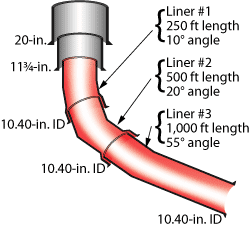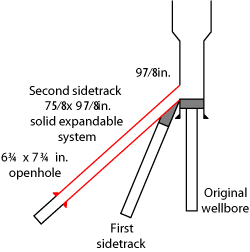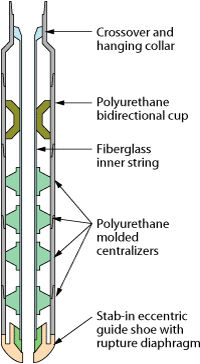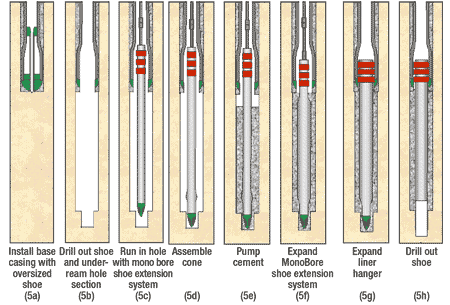Single diameter expandable casing applications continue to advance
But the pace is slow, as the high cost of the technology keeps it to a niche category of applications.Perry A. Fischer, Editor It’s been a long-term goal-a “holy grail” of well construction-to create a well with only one diameter of casing. The savings in time, fluids, cement, hangers and other hardware, preventing constricted completions and their effect on production, and many other advantages are well documented,1 and they apply roughly in proportion to the “slimness” of the well. In other words, advantages accrue if just one string of intermediate, “telescoping” casing can be eliminated. However, the added cost of expandables can offset the savings in fluids, cement, etc., such that operators are only using the technology when they have to. But there are signs that this may be changing. We still have some time-perhaps five or more years-before we see a relatively deep well drilled with only a surface conductor and a single-diameter expandable pipe. What’s needed are improvements in: fatigue resistance; burst and collapse pressures; the speed with which the pipe expands; the ability to make the downhole work performed in one trip, including expansion(s), cementing, sleeve-sliding (if any), excess pipe cutoff and so on. Other improvements needed include expansion cones and associated equipment qualified for HPHT applications; the ability to over-expand (i.e., form a bell) in casing sizes as small as 5 in.; lower cost; and operators’ having sufficient familiarity-that is, a “comfort zone”-with the technology, which will only come with routine use. The strength issue is gradually being addressed with thicker casings, cones and launchers being built to higher specifications, and it should be remembered that in the overwhelming majority of cases, expanded pipe is reinforced by covering it with a production liner, which is often tied back to the surface. Routine use of single-diameter technology is not the case today, and most of the money is still spent on contingencies. But even the word “contingency” is getting blurred, for if you’ve planned on and ordered technology that will likely, but not certainly, be used, is it really a contingency? Perhaps “planned workaround” is a better term. The service providers are trying to make the case that solid expandable tubulars don’t just solve problems, they also save money. But with a little luck, a lot of hard work and some vigorous competition, prices should come down as experience goes up. This article is a status report on how far this technology has progressed to date. DEFINITIONS Some definitions will help ensure that everyone understands the terminology, which has been a little confusing, in part due to competition and marketing. Single-diameter well construction is a general term used herein that simply means building a wellbore with a single-diameter casing that normally would require more than one diameter. The term MonoBore is being used by Weatherford, and is most often used to describe its MetalSkin liner/hanger system, when it is installed without a loss in well diameter between the parent casing and the liner. MonoDiameter is used by Enventure Global Technology. It involves an over-expansion at the bottom of the originally installed, expanded casing string, thus creating a bell. The bell receives the upper end of the next string that is expanded, the bottom of which also receives an over-expansion, thus creating a bell, which receives the top of the next expanded casing, and so on. The company remains the only one that has successfully accomplished this. It’s worth noting that, in casual conversation, all of these terms might be used interchangeably, much to the chagrin of the vendors who have tried hard to make them distinctive. The situation may get worse if all three vendors begin offering variations of the same technologies, including offering the “true” single-diameter borehole. BACKGROUND AND HISTORY In a general way, we can say that some aspects of expandable tubulars are becoming mature. To make these very long sections of wellbore, and eventually entire wells, single-diameter liners and wells require the experience of hundreds of jobs done with expandable tubulars of all shapes and sizes, including screens, junctions, threaded connections, seals, patches and so on. Enventure, for instance, says that it has completed nearly 1,000 jobs using expandables, with an overall reliability of 96%, including contingency installations. Baker Hughes is having success with last year’s introduction of a recessed shoe for single-diameter liner installations. The shoe has seen 10 installations, many of which had nothing to do with expandable casing. Narrowing the topic to just single-diameter well construction, we have the following achievements. Single-diameter wells. The first MonoDiameter well experiment was conducted by Shell and Enventure in South Texas in mid-2002. It resulted in successful expansion of two short sections in a well, one expansion going up, using a 9.9-in. cone from a launcher assembly, and one down, with a 10.4-in. cone pushed down by drill pipe. It established the principle that a true single-diameter well could be constructed. The expanded section began in a “pre-formed bell” that was just a heavy-weight piece of larger casing, run on the end of the parent casing. Near the end of 2004, Shell and Enventure completed testing of a major advancement in MonoDiameter well construction. The tests, conducted in a South Louisiana well, showed that the two expansions (bell and pipe) could be made in one trip. It also showed that casing could be expanded directly onto formation rock (clad), although that is not essential to the process.2 Last year, Enventure completed what can be called the world’s first commercial application of a section of true single-diameter well, in that it required three consecutive runs of expandable pipe, as well as the downhole over-expansion on two strings to create bells so as not to lose wellbore diameter. The three runs were done in the vertical, build and highly deviated well sections, Fig. 1.
Long, single-diameter liner runs. Enventure and operator Nexen set a world record in late March 2007 for installing the longest expandable liner system to date-6,867 ft of 7 5/8 × 9 7/8-in. pipe in open hole at Nexen’s Aspen-1 well in the Gulf of Mexico, drilling in 3,143 ft of water. The longest expandable liner before this was about 5,000 ft. The operator was drilling through depleted sands in its deepwater well. Through the use of Enventure’s OHL expandable system, TD was attained with the desired hole size. It was worth the cost and effort to reach TD with a 7-in. flush-joint liner to improve production levels and lower mechanical risk in the completion, as opposed to a conventional completion using 5½-in. liner that would have limited production. The record installation was in a second sidetrack at 20,000 ft, Fig. 2. The operator’s first sidetrack failed due to stuck drillstring after encountering high-pressure sands. The operator drilled a 9½-in. hole with a reamer and an 8½-in. bit, then ran and cemented the expandable liner. Expansion required 3,600 psi of pressure to start and provided a 7.710-in. ID with clearance for a subsequent 7-in. production liner. A new, higher-specification cone-launch assembly was built and tested two weeks before the start of the job.3
Two similar jobs were preformed by Enventure. One was an 8 5/8 × 10¾-in. expandable liner in 4,600 ft of water, which ran about 6,700 ft of liner and also required a higher-specification launcher. The other job took place in 5,600 ft of water, where 4,675 ft of 9 5/8 × 11 7/8-in. openhole liner was run to 22,600 ft. Weatherford has been making strides with a recess shoe, similar in principal to Baker’s recess shoe (see World Oil, July 2007), but with significant differences in function. The new shoe is bell-shaped and can prevent loss of hole ID, provided it is run as a planned contingency, where it is attached to the bottom of the parent casing, Fig. 3. It is lined in fiberglass to protect it from cement and to allow easy mill-out.
The bell’s profile is what receives the expanded pipe. The expansion and run sequence is shown in Fig. 4. Although Weatherford has run many of its conventional expandable MetalSkin Open-Hole Liner system, which, like most “conventional” expandable liners, does result in at least some loss of ID, the company’s new MetalSkin MonoBore system has been used in well designs as a planned contingency. A key to its implementation is the use of an 113/4 × 133/8-in. openhole expandable liner. It was successfully field tested, but thus far has not actually been installed commercially in a well, since, so far, operators have opted not to use the planned contingency and have completed their wells conventionally. Use of the larger-diameter expandable higher in the wellbore can convey greater hole-diameters and more options for contingency planning.
LOOKING AHEAD Single-diameter well construction today is usually done to get past difficult spots in the well. These generally arise when the pressure is too great or too little, as with overpressured or depleted zones. Differential sticking and/or gas influx is often the result. The ultimate holy grail of well construction will come when we directionally drill using an expandable liner for drill pipe (i.e., casing while drilling). Casing while drilling not only saves casing-running time, it creates a smaller annulus and it tends to “pack off” the borehole with its “plastering effect.” This not only will overcome the problems that single-diameter well construction is usually used for, but it will also accrue additional time and cost savings, as well as add another measure of safety to the drilling process. Meanwhile, the number and uses of single-diameter well construction will only increase, particularly as a planned element in the well-construction design from the start. Competition, ingenuity and operator experience will inevitably grow. Click here for a complete list of World Oil’s annual expandable technology reports. LITERATURE CITED 1 Dean, B. et al, “Monodiameter drilling liner-from concept to reality,” SPE/IADC 79790, SPE/IADC Drilling Conference, Amsterdam, Netherlands, Feb. 19-21, 2003.
|
- Coiled tubing drilling’s role in the energy transition (March 2024)
- Using data to create new completion efficiencies (February 2024)
- Digital tool kit enhances real-time decision-making to improve drilling efficiency and performance (February 2024)
- E&P outside the U.S. maintains a disciplined pace (February 2024)
- U.S. operators reduce activity as crude prices plunge (February 2024)
- Drilling advances (January 2024)






